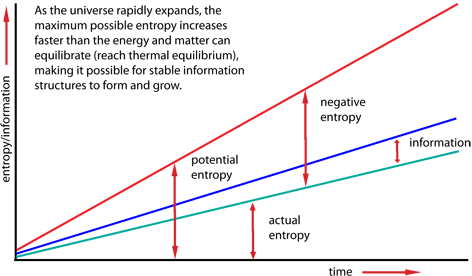The Information Philosopher proposes to show that everything created since the origin of the universe over ten billion years ago has involved just two fundamental physical processes that combine to form the core of all creative processes. These two steps occur whenever even a single bit of new information is created and comes into the universe.
- Step 1: A quantum process - the "collapse of a wave function."
The formation of even a single bit of information that did not previously exist requires the equivalent of a "measurement." This "measurement" does not involve a "measurer," an experimenter or observer. It happens when the probabilistic wave function that describes the possible outcomes of a measurement "collapses" and a matter or energy particle is actually found somewhere.
- Step 2: A thermodynamic process - local reduction, but cosmic increase, in the entropy.
The second law of thermodynamics requires that the overall cosmic entropy always increases. When new information is created locally in step 1, some energy (with positive entropy greater than the negative entropy of the new information) must be transferred away from the location of the new bits or they will be destroyed, if local thermodynamical equilibrium is restored. This can only happen in a locality where flows of matter and energy with low entropy are passing through, keeping it far from equilibrium.
This two-step core creative process underlies the formation of microscopic objects like atoms and molecules, as well as macroscopic objects like galaxies, stars, and planets.
With the
emergence of teleonomic (purposive) information in self-replicating systems, the same core process underlies all biological creation. But now some
random changes in information structures are rejected by natural selection, while others reproduce successfully.
Finally, with the emergence of self-aware organisms and the creation of extra-biological information stored in the environment, the same information-generating core process underlies communication,
consciousness,
free will, and
creativity.
The two physical processes in the creative process, quantum physics and thermodynamics, are somewhat daunting subjects for philosophers, and even for many scientists.
By creation we mean the
emergence or coming into existence of recognizable information structures from a prior chaotic state in which there is no recognizable order or information.
Note there are three distinct kinds of emergence:
- the order out of chaos when the matter in the universe forms information structures
- the order out of order when the material information structures form self-replicating biological information structures
- the immaterial information out of order when organisms with minds externalize information, communicating it to other minds and storing it in the environment
By information we mean a quantity that can be understood mathematically and physically. It corresponds to the common-sense meaning of information, in the sense of communicating or informing. It also corresponds to the information stored in books and computers. But it also measures the information in any physical object, like a recipe, blueprint, or production process, and the information in biological systems, including the genetic code and the cell structures.
Ultimately, the information we mean is the departure of a physical system from pure chaos, from "thermodynamic equilibrium." In equilibrium, there is only motion of the microscopic constituent particles ("the motion we call heat"). The existence of macroscopic structures, such as the stars and planets, and their motions, is a departure from thermodynamic equilibrium.
Information is mathematically related to the measure of disorder known as the entropy by
Ludwig Boltzmann's famous formula
S = k log
W, where
S is the entropy and
W is the probability - the number of ways that the internal components (the matter and energy particles of the system) can be rearranged and still be the same system.
The second law of thermodynamics says that the entropy (or disorder) of a closed physical system increases until it reaches a maximum, the state of thermodynamic equilibrium. It requires that the entropy of the universe is now and has always been increasing.
This established fact of increasing entropy led many scientists and philosophers to assume that the universe we have is "running down" to a "heat death." They think that means the universe began in a very high state of information, since the second law requires that any organization or order is susceptible to decay. The information that remains today, in their view, has always been here. There is nothing new under the sun.
But the universe is not a
closed system. It is in a dynamic state of expansion that is moving away from thermodynamic equilibrium faster than entropic processes can keep up. The maximum possible entropy is increasing much faster than the actual increase in entropy. The difference between the maximum possible entropy and the actual entropy is potential information, as shown by
David Layzer.

Creation of information structures means that in parts of the universe the local entropy is actually going down. Creation of a low entropy system is always accompanied by radiation of entropy away from the local structures to distant parts of the universe, into the night sky for example.